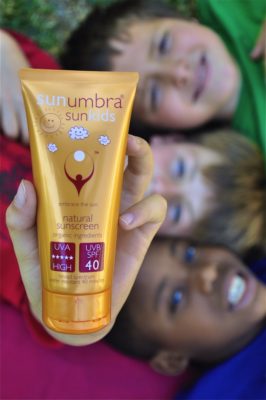It’s that time of year when glorious sunshine invites us outdoors. Ignoring the potential negative effects can spoil it all. Sue Ingram, CEO and Developer of Sunumbra P Natural Sunscreens shares some summertime sun safety tips.
The simple truth
Sunburns look and feel awful. Beyond peeling skin, they can create unbelievably sore, huge red blisters. These add to your wrinkle quota as you age, providing a base for skin cancer, which can cause disfigurement or even death.

Tips to help you embrace the sunshine
Know your skin
Pale skin burns easily, and although dark skin copes with the sun more naturally, sunburn happens too – it just takes a little longer. Depending on your skin type, time of day, the sun’s strength (check the UV Index), and your age – you can manage the risk of burn.
Wear protective clothing
A simple first choice to protect you from the UV rays. Choose close weave fabrics, a broad brimmed hat and long sleeves.
Seek out shade
Take breaks under trees, umbrellas or beach canopies.
Plan around the sun
Avoid the midday UVB radiation peak with early morning or late afternoon outings. Although midday is the best time to create Vitamin D, a hormone manufactured by the skin in the presence of the UVB rays, it is also the quickest time to get sunburnt.
Wear quality sunglasses
Beyond a fashion accessory, they protect your eyes from UV damage. A day outdoors without proper eye protection can cause temporary, painful burns to the eye surface, like sunburn. Reflected sunlight from sand or snow is especially dangerous.
Extra caution for Children
Take extra care to protect infants, as their skin is much more sensitive than adult skin – to synthetic chemicals, as well as the sun’s UV rays. Blistering sunburns in childhood doubles their lifetime chances of developing serious skin cancer. Children under six months should be kept out of sunlight completely, as most sunscreens advise. If there’s no choice, make sure to cover them with clothing or shade and apply a natural sunscreen to exposed skin. Their extra sensitive skin really doesn’t want to have to deal with synthetic sunscreen chemicals. A natural zinc oxide based sunscreen is the best choice by far.
Stay hydrated
Being active outdoors in the summer heat requires extra water. Don’t wait until you’re thirsty to drink water, rather keep hydrated. Heat exhaustion happens when your body can’t cool itself fast enough and can come on suddenly and you just collapse. Heat stroke is way more serious where you stop sweating, have red, hot skin and a high temperature. You can be uncoordinated, confused or even lose consciousness. React with emergency medical attention. Children need to be watched especially for overheating, a headache, dizziness, nausea, fatigue and weakness. Get them out of the sun, give them lots of liquid and get medication.
The good news is that the sun doesn’t have to be your enemy if you wear sunscreen, drink water and take breaks when you start to feel too hot. Plus don’t forget the sunglasses. Not only do they protect your eyes from the sun, they make you look cool!
Choosing and using a healthy sunscreen
Don’t fall for high SPF. Anything over SPF 50 can tempt you to stay in the sun too long and damage your skin at a deeper level from the UVA rays. Pick a SPF between 15 and 50+, depending on skin type and time to be exposed.
Broad spectrum. Good protection from both UVA and UVB rays.
Water resistance. Important for swimming but also helps with sweating.
Natural sunscreens. Choose zinc oxide for best broad spectrum protection and avoid avobenzone especially, plus other synthetic chemicals.
Avoid Vitamin A. Research shows tumors and lesions develop sooner on skin with creams with vitamin A exposed to sunlight.
Apply efficiently. Applying too little sunscreen will undermine its effectiveness. Don’t forget ears, backs of legs, back of the neck and feet. And especially bald heads!
Reapply often. At least every two hours, after towel drying or sweating, after being in water, or if it has rubbed off.






